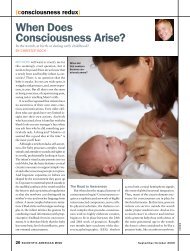Regaining the Rainbow - The Koch Lab - California Institute of ...
Regaining the Rainbow - The Koch Lab - California Institute of ...
Regaining the Rainbow - The Koch Lab - California Institute of ...
You also want an ePaper? Increase the reach of your titles
YUMPU automatically turns print PDFs into web optimized ePapers that Google loves.
(consciousness redux)<br />
<strong>Regaining</strong> <strong>the</strong> <strong>Rainbow</strong><br />
Genetic intervention cures color blindness in monkeys<br />
By christ<strong>of</strong> <strong>Koch</strong><br />
<strong>the</strong>re is ample evidence that men<br />
and women think, express <strong>the</strong>mselves<br />
and even experience emotions differently<br />
(for more details, read on through this<br />
issue). But in <strong>the</strong> area <strong>of</strong> sensory perception,<br />
psychologists are hard-pressed to<br />
identify major discrepancies. By and<br />
large, <strong>the</strong> way <strong>the</strong> two genders experience<br />
<strong>the</strong> sounds, sights and smells <strong>of</strong> life<br />
is quite similar. <strong>The</strong> most striking exception<br />
may be found, at least for some, in<br />
<strong>the</strong> perception <strong>of</strong> colors.<br />
Seeing in color is a complex process, as<br />
you may remember from your school<br />
days. It starts with <strong>the</strong> delicate lining <strong>of</strong><br />
<strong>the</strong> eyes, a structure called <strong>the</strong> retina. Retinal<br />
tissue contains light-sensitive cells<br />
that absorb wavelengths in <strong>the</strong> visible<br />
spectrum and convert <strong>the</strong>m into electrical<br />
signals. <strong>The</strong> brain interprets this information<br />
as <strong>the</strong> riot <strong>of</strong> colors we consciously<br />
experience. <strong>The</strong> retinal cells called cones<br />
come in three varieties. <strong>The</strong> S-type cone<br />
is maximally sensitive to light in <strong>the</strong><br />
short-wavelength (blue) part <strong>of</strong> <strong>the</strong> visible<br />
spectrum, <strong>the</strong> M-type cone responds best<br />
to medium wavelengths, and <strong>the</strong> L-type<br />
to long, reddish wavelengths. People with<br />
normal color vision are known as trichromats<br />
because <strong>the</strong>y possess <strong>the</strong>se three<br />
kinds <strong>of</strong> photosensitive cone cells.<br />
About 8 percent <strong>of</strong> men, but fewer<br />
than 1 percent <strong>of</strong> women, have impoverished<br />
color vision, typically because <strong>the</strong>y<br />
lack <strong>the</strong> gene for ei<strong>the</strong>r <strong>the</strong> L- or <strong>the</strong> Mtype<br />
photopigment. While <strong>the</strong>ir vision is<br />
normal in every o<strong>the</strong>r way, <strong>the</strong>y suffer<br />
from what is <strong>of</strong>ten called red-green color<br />
blindness. Depending on <strong>the</strong> specific genetic<br />
omission involved, such people—<br />
who are known as dichromats because<br />
<strong>the</strong>y have only two types <strong>of</strong> cone cells—<br />
are unable to distinguish between violet,<br />
lavender and purple or between red, orange,<br />
yellow and green.<br />
It’s not a tremendous handicap, but it<br />
can make traffic lights—especially hori-<br />
men are more<br />
<strong>of</strong>ten color-blind<br />
because two genes<br />
that enable <strong>the</strong> eye<br />
to absorb light sit<br />
on <strong>the</strong> X chromosome.<br />
men have<br />
only one X; women<br />
have a backup.<br />
zontal ones—as well as warning lights<br />
that flash ei<strong>the</strong>r yellow or red hard to decode.<br />
And a lack <strong>of</strong> sensitivity to reddish<br />
hues makes it almost impossible for a dichromat<br />
to detect <strong>the</strong> onset <strong>of</strong> sunburn.<br />
(<strong>The</strong> photographs on <strong>the</strong> opposite page<br />
show <strong>the</strong> sickly-looking hue <strong>of</strong> skin as<br />
seen through color-blind eyes.)<br />
<strong>The</strong> reason color blindness is so much<br />
more common in boys and men is that <strong>the</strong><br />
two genes for <strong>the</strong> L- and M-type photopigments—<strong>the</strong><br />
substances in cone cells<br />
that absorb light—are carried on <strong>the</strong> X<br />
chromosome. A girl who inherits one defective<br />
copy <strong>of</strong> such a gene from her parents<br />
has a backup on her o<strong>the</strong>r X chromosome.<br />
Because men have only one X chromosome<br />
(<strong>the</strong>ir paired sex chromosome is<br />
a Y), <strong>the</strong>y lose out. Interestingly, also<br />
thanks to <strong>the</strong> vagaries <strong>of</strong> genetics, some<br />
women are endowed with four kinds <strong>of</strong><br />
photosensitive cones instead <strong>of</strong> <strong>the</strong> standard<br />
three. <strong>The</strong>oretically, <strong>the</strong>se so-called<br />
tetrachromats can identify subtleties <strong>of</strong><br />
shading that are indistinguishable to <strong>the</strong><br />
rest <strong>of</strong> us; however, this phenomenon has<br />
been hard to confirm experimentally.<br />
color correction<br />
Unlike humans, most mammals possess<br />
just two kinds <strong>of</strong> retinal cones. Thus,<br />
mice, cats and dogs see <strong>the</strong> world much <strong>the</strong><br />
way a red-green color-blind person does,<br />
making <strong>the</strong>m ideal experimental subjects.<br />
A few years ago scientists at <strong>the</strong> Johns<br />
Hopkins School <strong>of</strong> Medicine inserted <strong>the</strong><br />
gene for <strong>the</strong> human L-type photopigment<br />
into mice. After several generations <strong>of</strong><br />
breeding, <strong>the</strong> mice responded to <strong>the</strong> extra<br />
hue information. <strong>The</strong>y had changed from<br />
dichromats to trichromats—a remarkable<br />
feat <strong>of</strong> bioengineering. <strong>The</strong> experiment<br />
also showed that mouse brains are flexible<br />
enough to receive and make use <strong>of</strong> <strong>the</strong> additional<br />
wavelength information.<br />
An even more ambitious experiment,<br />
extending over a decade, came recently<br />
to fruition. It was conducted by <strong>the</strong> husband-and-wife<br />
team <strong>of</strong> Jay Neitz and<br />
Maureen Neitz, both pr<strong>of</strong>essors at <strong>the</strong><br />
16 scientific american mind may/June 2010<br />
christ<strong>of</strong> koch (<strong>Koch</strong>); oleksiy maksymenko All Canada Photos/Corbis (rainbow eye)
christ<strong>of</strong> koch<br />
( We could potentially extend human vision into )<br />
<strong>the</strong> ultraviolet or infrared: <strong>the</strong> superhero spectrum.<br />
University <strong>of</strong> Washington School <strong>of</strong><br />
Medicine, and <strong>the</strong>ir collaborators. <strong>The</strong><br />
work involved squirrel monkeys, a species<br />
indigenous to Central and South<br />
America. Among <strong>the</strong>se primates, most<br />
females are trichromats, but <strong>the</strong> males<br />
are dichromats, possessing only <strong>the</strong> S-<br />
and M-type photopigments. Accordingly,<br />
it is <strong>the</strong> females that lead troops <strong>of</strong><br />
monkeys to search for ripe fruits among<br />
<strong>the</strong> foliage, a quest that requires superior<br />
color discrimination skills.<br />
<strong>The</strong> Neitzes wondered: Could gene<br />
<strong>the</strong>rapy “cure” <strong>the</strong> male monkeys’ color<br />
blindness? To find out, <strong>the</strong> biologists developed<br />
a way to incorporate <strong>the</strong> gene for<br />
<strong>the</strong> human L-type photopigment into a<br />
small virus known as adeno-associated<br />
virus. Next <strong>the</strong>y injected tens <strong>of</strong> trillions<br />
<strong>of</strong> viral particles into <strong>the</strong> monkeys’ eyes.<br />
Twenty weeks later up to one third <strong>of</strong> <strong>the</strong><br />
M-type cones in <strong>the</strong> animals’ retinas had<br />
begun to express <strong>the</strong> L-type photopigment.<br />
In o<strong>the</strong>r words, <strong>the</strong> monkeys now<br />
had not two but three cone types: in addition<br />
to <strong>the</strong>ir original S-type and Mtype<br />
cones, <strong>the</strong>y had new M-type cones<br />
whose sensitivity had shifted toward <strong>the</strong><br />
long-wavelength part <strong>of</strong> <strong>the</strong> spectrum.<br />
<strong>The</strong> million-dollar question was<br />
whe<strong>the</strong>r <strong>the</strong> rest <strong>of</strong> <strong>the</strong> animals’ central<br />
nervous system could reprogram itself to<br />
make use <strong>of</strong> this additional information.<br />
Using a computer-administered color<br />
test, <strong>the</strong> Neitzes demonstrated that <strong>the</strong><br />
treated monkeys, like <strong>the</strong> mice from <strong>the</strong><br />
earlier experiment, did indeed discriminate<br />
among colors.<br />
<strong>The</strong> monkeys’ new color awareness<br />
emerged as soon as <strong>the</strong> photopigments<br />
were expressed in <strong>the</strong>ir retinas. <strong>The</strong> lack<br />
<strong>of</strong> delay suggests that preexisting retinal<br />
two views <strong>of</strong> <strong>the</strong> author’s right deltoid: a regular one (left), and a manipulated one (right) that<br />
suggests how it would look to a color-blind person who doesn’t see reddish wavelengths.<br />
and cortical circuitry can incorporate <strong>the</strong><br />
additional information; no time-consuming<br />
rewiring was necessary. It also suggests<br />
how <strong>the</strong> evolutionary transition<br />
from two- to three-cone color vision<br />
might have come about.<br />
from monkeys to People<br />
Two years after <strong>the</strong> Neitzes’ experiment<br />
<strong>the</strong>ir monkeys’ color vision remains<br />
transformed. Being <strong>the</strong> careful scientists<br />
<strong>the</strong>y are, <strong>the</strong>y do not take a stand on<br />
whe<strong>the</strong>r or not <strong>the</strong> monkeys see novel<br />
reddish hues. Yet I find no principled reason<br />
to deny it. <strong>The</strong> retinal machinery for<br />
trichromacy is present, and <strong>the</strong> monkeys’<br />
behavior indicates that <strong>the</strong>y experience<br />
<strong>the</strong>se hues. Within a few years electrophysiological<br />
and functional imaging experiments<br />
will inform us whe<strong>the</strong>r <strong>the</strong> an-<br />
(Fur<strong>the</strong>r Reading)<br />
imals show increased processing in <strong>the</strong><br />
regions <strong>of</strong> visual cortex dedicated to color<br />
perception. I would bet 100 to one<br />
that <strong>the</strong>y do.<br />
<strong>The</strong> virus used in this experiment is<br />
safe—it doesn’t replicate by itself, doesn’t<br />
cause disease and triggers only a mild<br />
immune response—and it has been approved<br />
for gene <strong>the</strong>rapy in humans. So<br />
this technique could be adapted to help<br />
color-blind people see normally. <strong>The</strong><br />
condition affects many millions in <strong>the</strong><br />
U.S. alone. Provided that <strong>the</strong> risk-to-benefit<br />
ratio <strong>of</strong> gene <strong>the</strong>rapy can be improved<br />
significantly, a potential cure could have<br />
a dramatic impact on <strong>the</strong> sensibilities <strong>of</strong><br />
a large slice <strong>of</strong> humankind.<br />
Jay Neitz believes that this operation<br />
will someday become as safe as refractive<br />
surgery such as Lasek. Methods such<br />
as <strong>the</strong> one <strong>the</strong> Neitzes have pioneered, as<br />
well as <strong>the</strong> optogenetic techniques discussed<br />
in my last column [see “Playing<br />
<strong>the</strong> Body Electric,” March/April 2010]<br />
may well, soon enough, make <strong>the</strong> (color)blind<br />
see again.<br />
Of course, <strong>the</strong>re is little reason to<br />
stop <strong>the</strong>re. Why not enhance visual experience<br />
to give <strong>the</strong> more adventuresome<br />
among us tetrachromacy? Or extend <strong>the</strong><br />
window <strong>of</strong> visibility up into <strong>the</strong> ultraviolet<br />
or down into <strong>the</strong> infrared for superherolike<br />
vision? Thanks to cutting-edge<br />
molecular biology, we can see our way<br />
into a trans human future. M<br />
christ<strong>of</strong> <strong>Koch</strong> is lois and victor troendle<br />
pr<strong>of</strong>essor <strong>of</strong> cognitive and Behavioral Biology<br />
at <strong>the</strong> california institute <strong>of</strong> technology. he<br />
serves on Scientific American Mind’s board<br />
<strong>of</strong> advisers.<br />
◆ Emergence <strong>of</strong> Novel Color Vision in Mice Engineered to Express a Human Cone<br />
Photopigment. G. h. Jacobs, G. a. Williams, h. cahill and J. nathans in Science,<br />
Vol. 315, pages 1723–1725; march 2007.<br />
◆ Gene <strong>The</strong>rapy for Red-Green Colour Blindness in Adult Primates. k. mancuso,<br />
W. W. hauswirth, Q. li, t. B. connor, J. a. kuchenbecker, m. c. mauck, J. neitz and<br />
m. neitz in Nature, Vol. 461, pages 784–787; october 2009.<br />
◆ <strong>the</strong> neitz laboratory Web site: www.neitzvision.com<br />
www.scientificamerican.com/mind scientific american mind 17






